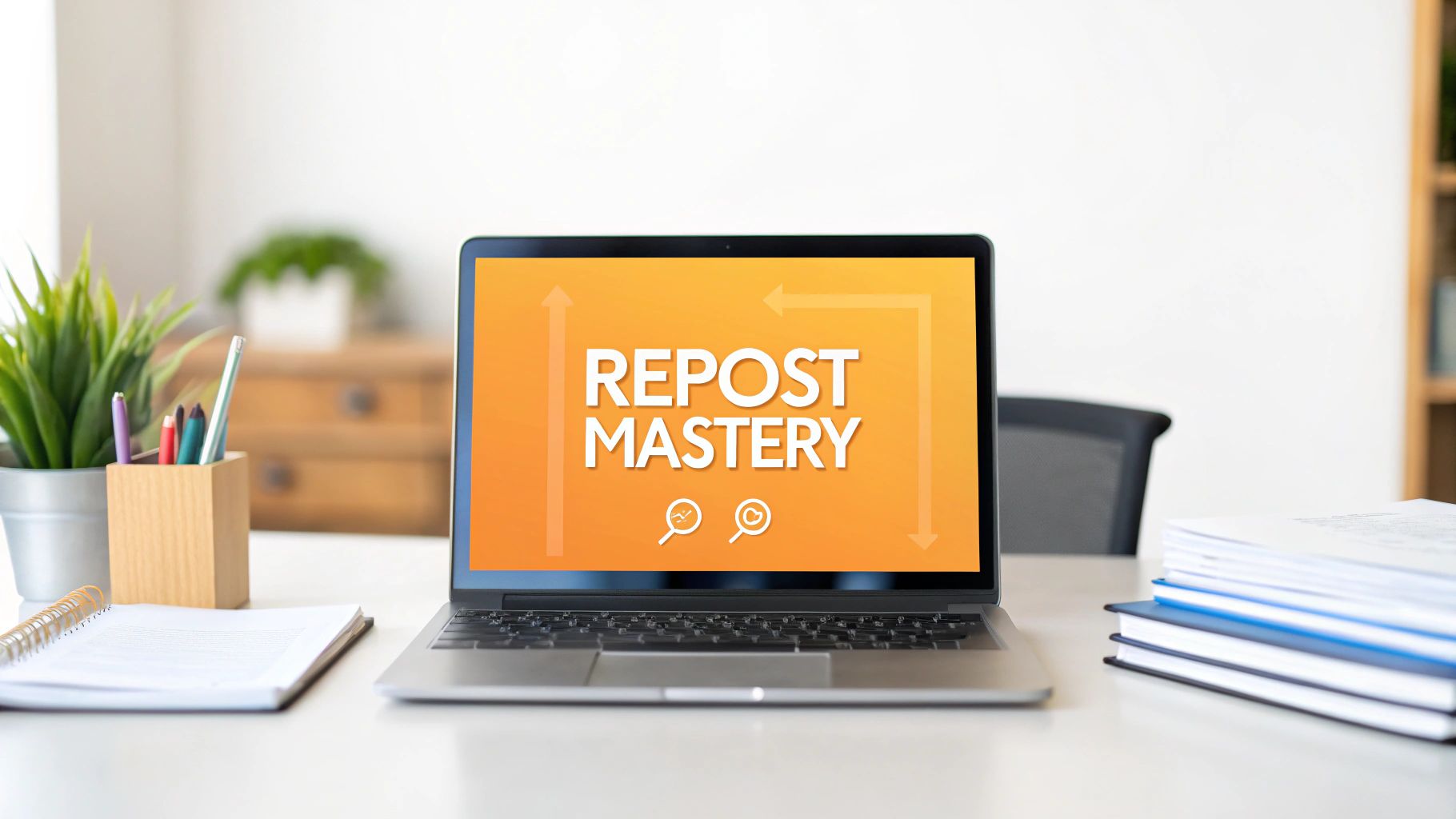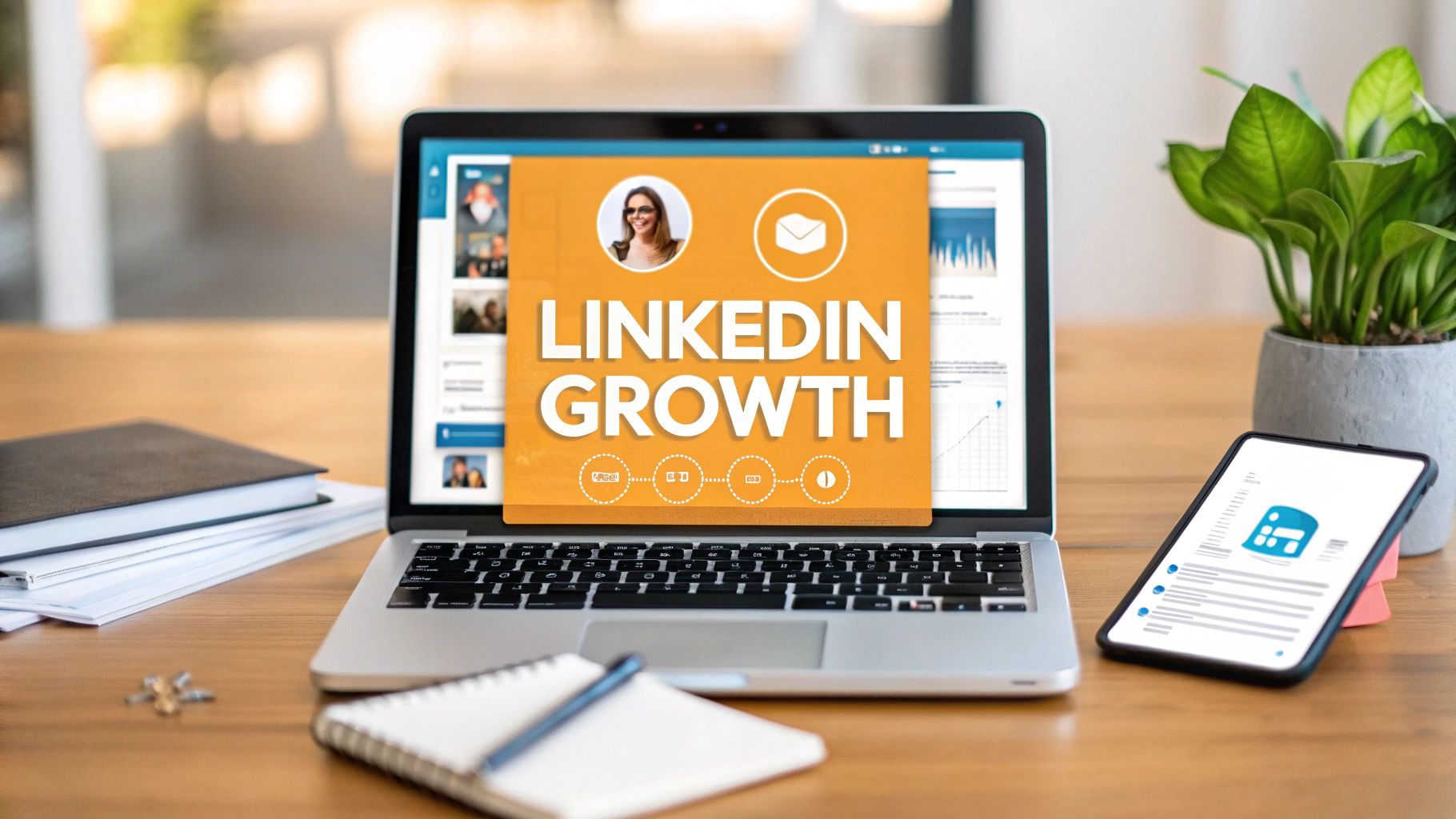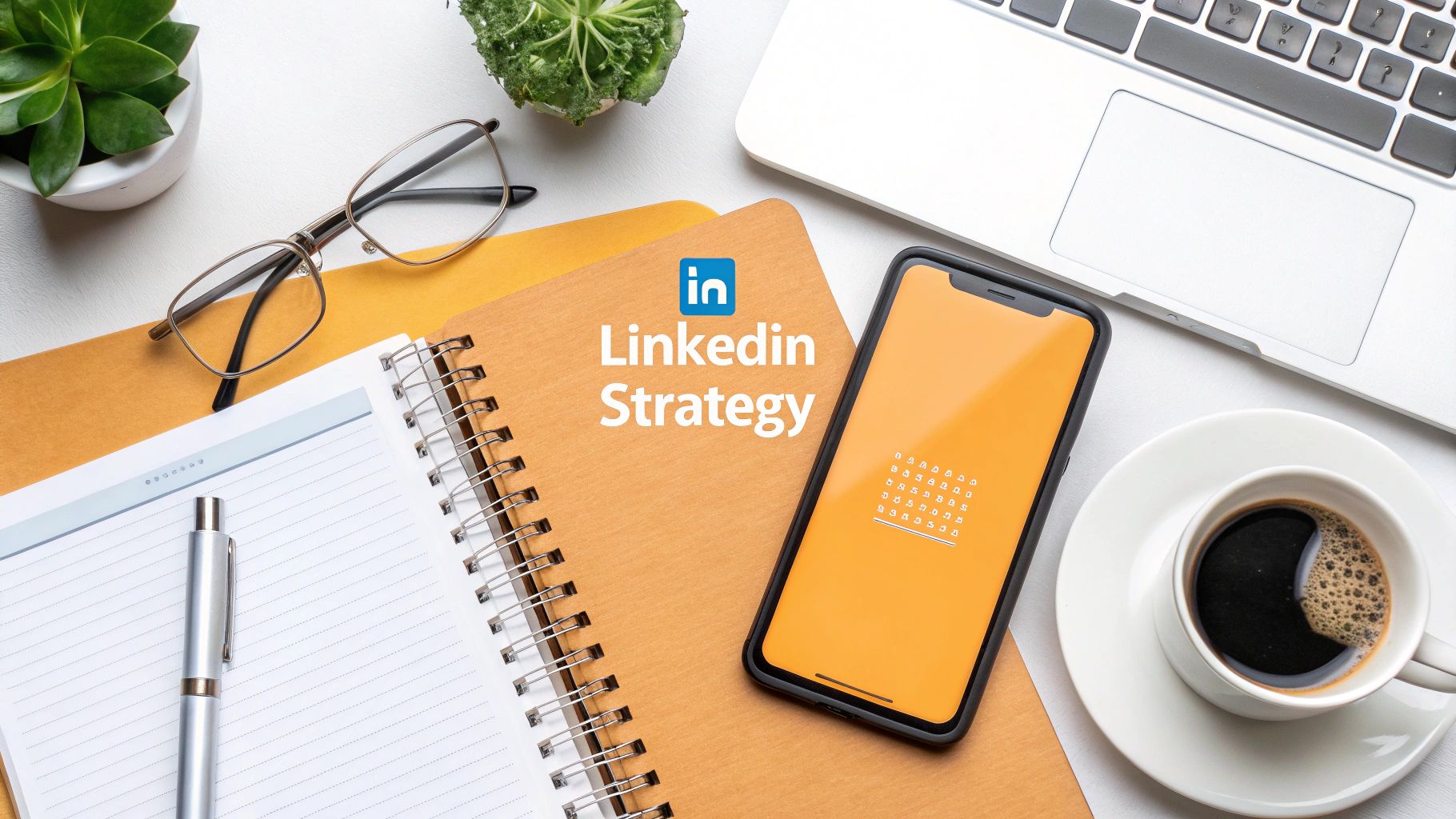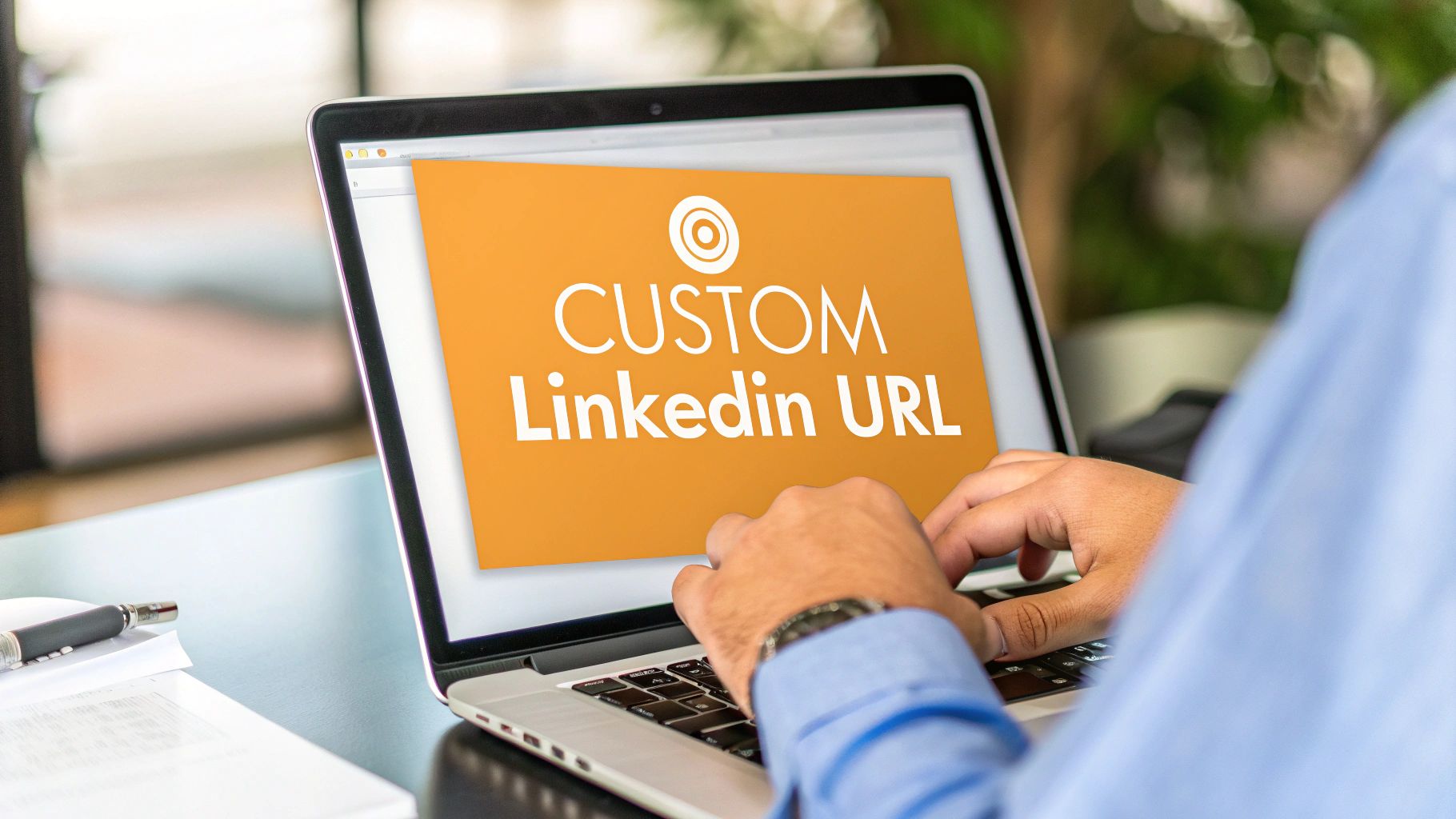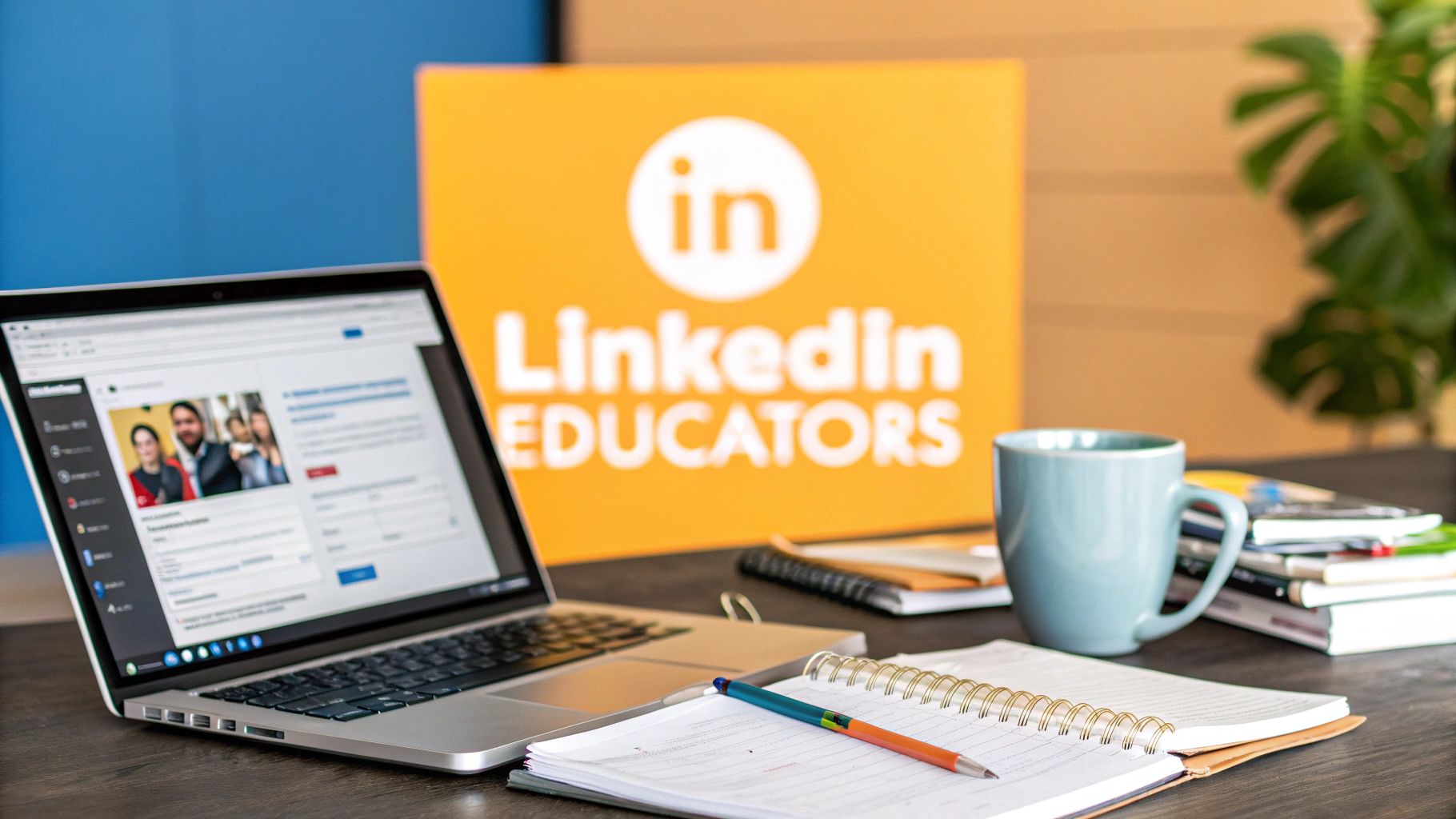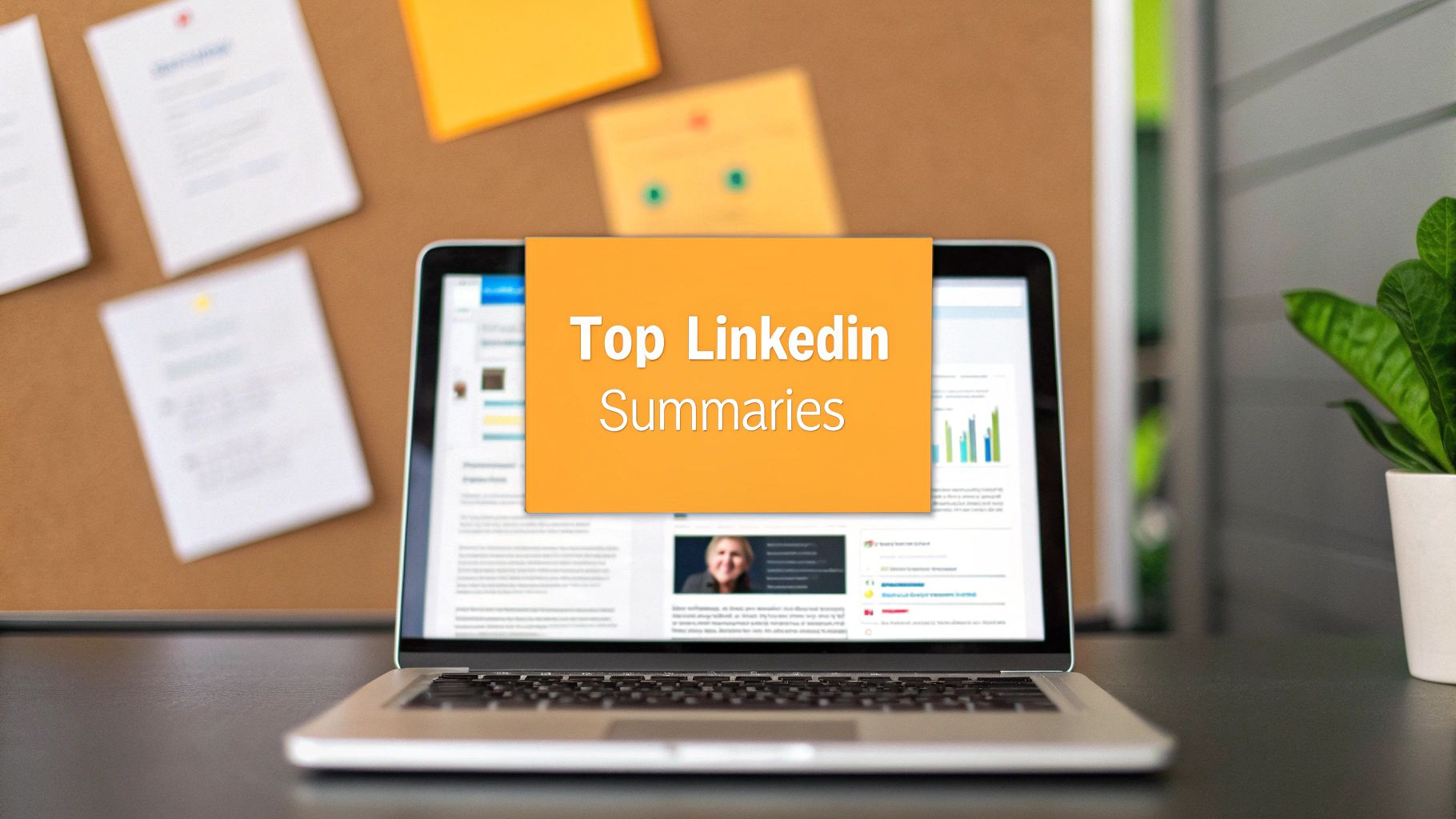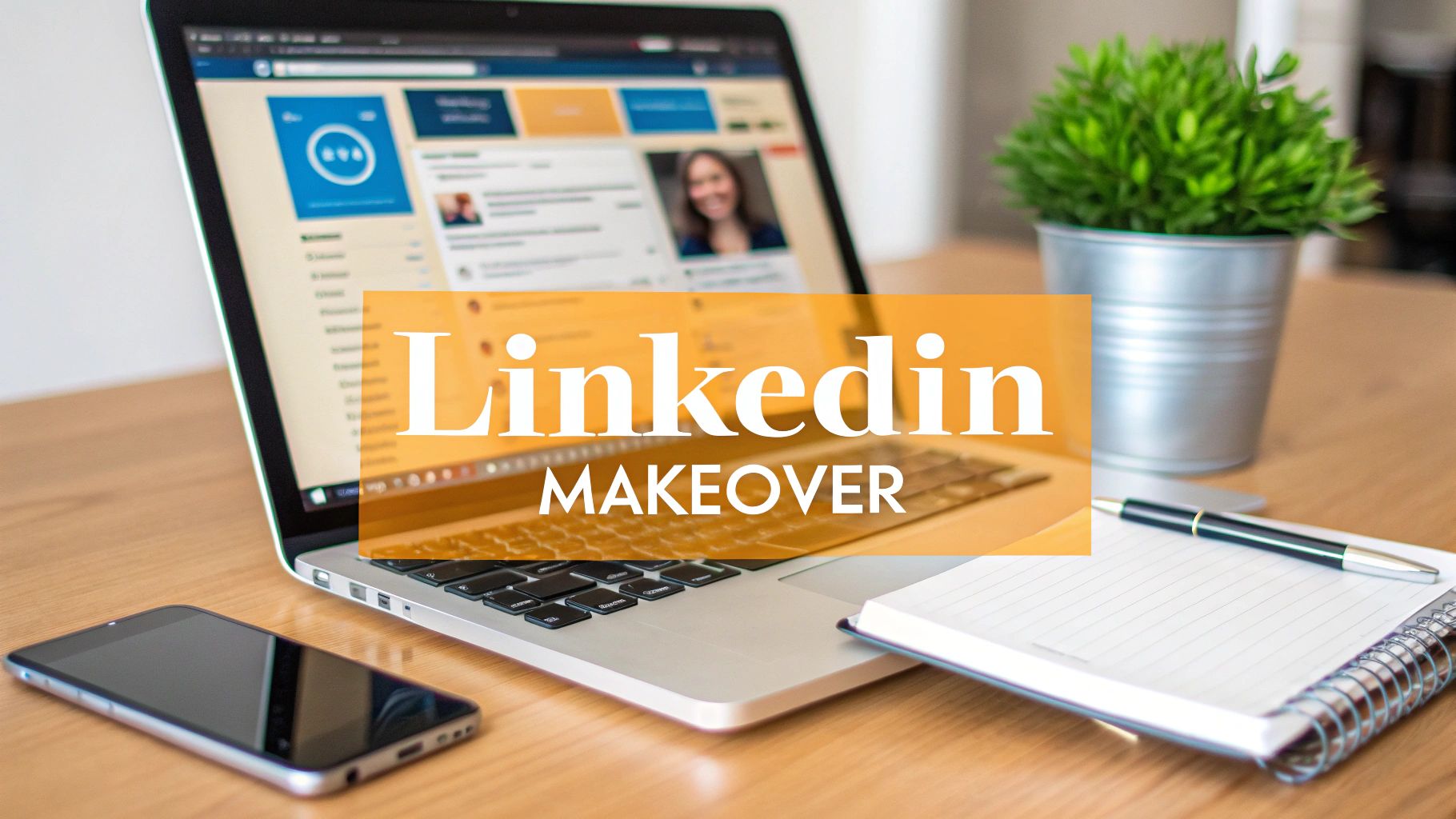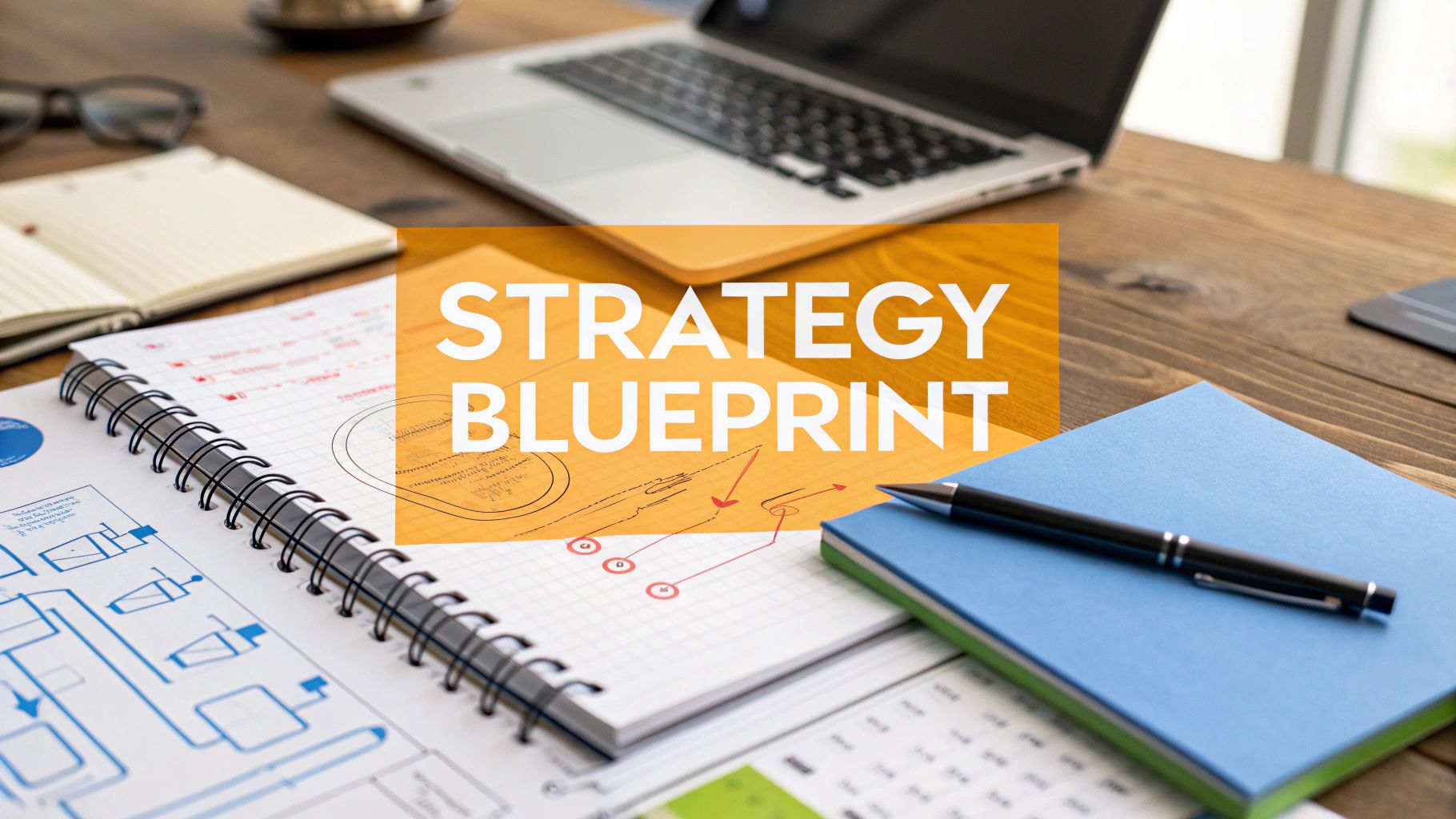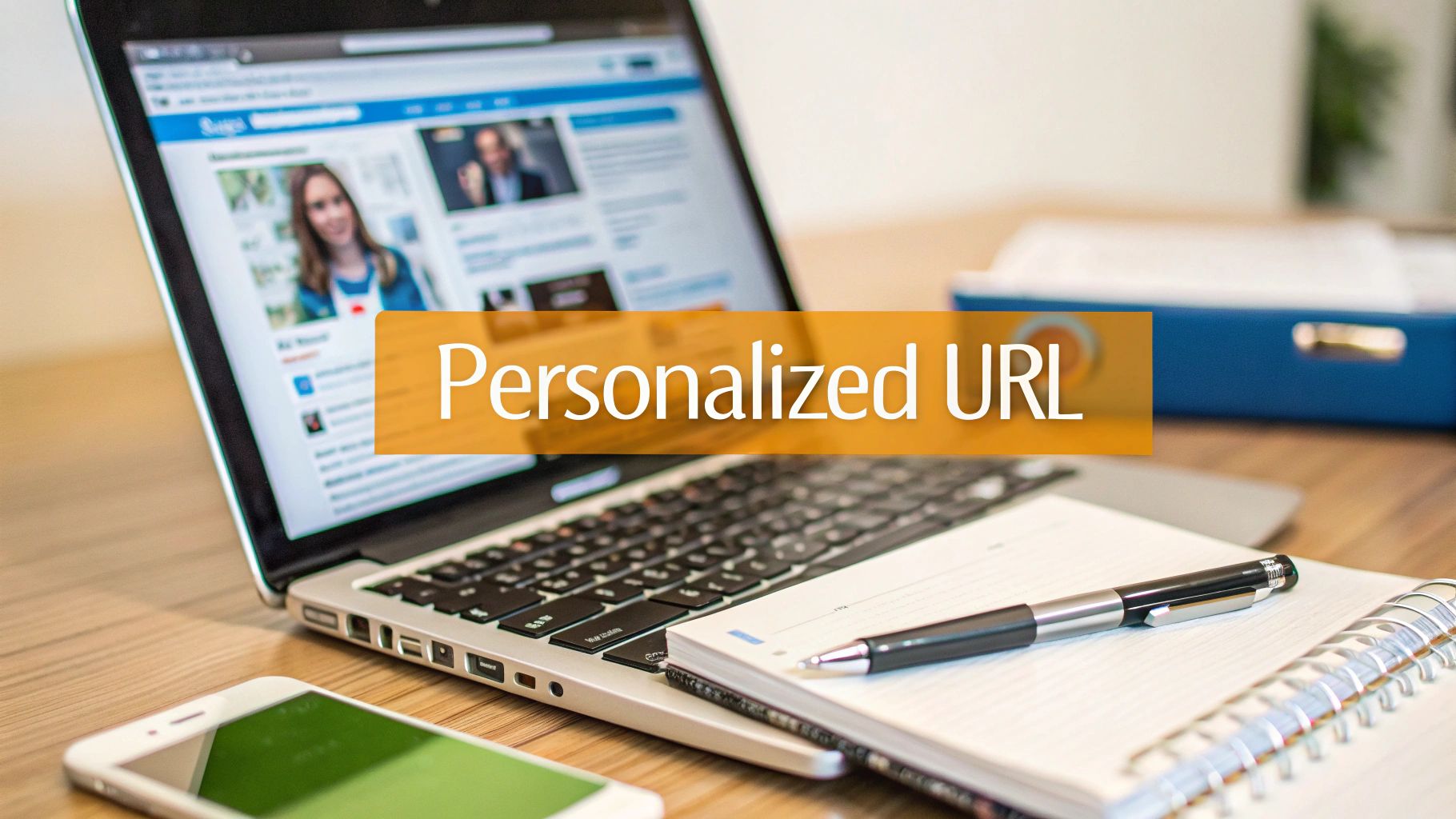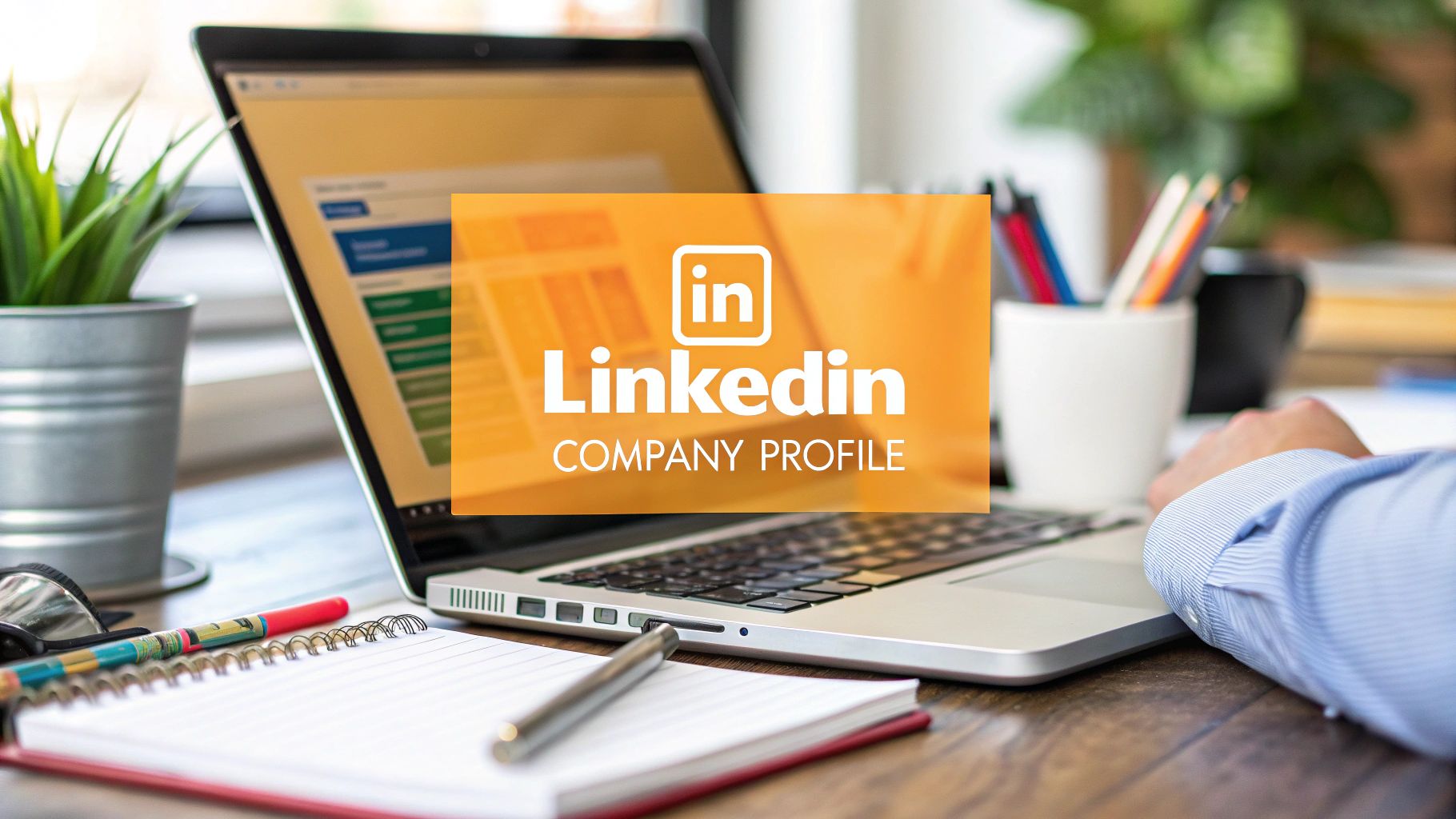Finding and hiring top talent isn't about luck; it's about running a smart, proactive playbook. Think of your candidates like you think of your best customers. The goal is to build a powerful employer brand, get strategic about sourcing talent (especially the ones who aren't looking), and design an interview process that’s both efficient and reveals true skills. It all ends with an offer they can't refuse.
The Modern Playbook for Attracting A-Players
The old "post a job and pray" strategy is dead. In today's market, the best people aren't scouring job boards—they're already employed and doing great work. To get their attention, you need a modern approach. This is less about just filling a seat and more about gaining a competitive edge by bringing in people who will genuinely move the needle for your business. The whole game shifts when you adopt a candidate-first mindset, where you're selling the opportunity just as much as they're selling themselves.
This perspective is everything because, let's be honest, it's tough out there. The global talent shortage isn't just a buzzword; it's the reality for most companies. A recent report found that a massive 76% of employers globally are having a hard time finding people with the right skills. That means for every four open roles, three companies are struggling. The competition for true A-players is fierce.
Adopting a Proactive Mindset
The old way was purely reactive: someone quits, you panic, post an ad, and wait. The modern playbook flips that script entirely. It's about being proactive. You should be building relationships and talent pipelines long before you even have a headcount approved. Recruiting becomes a constant, strategic part of your business, not just a frantic response to a two-weeks' notice.
Here’s what that looks like in practice:
- Always Be Sourcing: You should constantly be identifying and connecting with interesting people in your field. Don't wait until you have an open req.
- Tell Your Story: Your careers page and social media aren't just for posting jobs. Use them to show off your culture, your mission, and what it’s actually like to work with you. Let your current employees be your biggest advocates.
- Nail the Candidate Experience: Every single interaction matters. From the very first message to the final offer, make sure the process is professional, clear, and respects their time.
The biggest shift in modern recruiting is moving from a transactional mindset to a relational one. You're not just filling a slot on an org chart; you're inviting someone to be a part of what you're building. When you see it that way, everything changes.
To really get ahead, you'll need some fresh outreach ideas. You can explore effective recruitment campaign ideas to attract top talent to find ways to break through the noise.
Let's break down the key stages of this process. This isn't a rigid, linear path but more of a funnel that guides great people from awareness to becoming part of your team.
The Modern Recruitment Funnel at a Glance
| Stage | Key Objective | Core Activity |
|---|---|---|
| Attraction | Build awareness & generate interest | Employer branding, content marketing, targeted advertising, job postings. |
| Engagement | Convert interest into applications | Personalized outreach, streamlined application, quick recruiter follow-up. |
| Screening | Identify qualified candidates | Resume review, phone screens, initial skills assessments. |
| Interview | Assess skills, culture fit, and motivation | Structured interviews, technical challenges, team interviews. |
| Offer | Secure the best candidate | Crafting a competitive offer, transparent negotiation, selling the vision. |
| Onboarding | Ensure a successful start | Pre-boarding engagement, structured Day 1, 30-60-90 day plan. |
This table shows how each stage has a distinct goal, from getting on a candidate's radar to making sure they feel welcome and set up for success from day one.
The infographic below visualizes this flow, breaking it into three macro-phases that are easy to remember.

As you can see, success hinges on a smooth, connected process. It's not about acing one step; it's about creating a seamless journey from that first "hello" to their first day on the job.
Build an Employer Brand That Top Talent Actually Wants to Work For

Long before you ever post a job opening, your company's reputation is out there, doing the heavy lifting for you. This is your employer brand—it’s the story people tell about what it's like to work at your company, and frankly, it’s your most powerful magnet for attracting A-players.
The best candidates aren't just looking for a paycheck. They're looking for a mission they can get behind, a team that inspires them, and a culture where they can do their best work. This isn't about slapping a generic mission statement on a wall. It’s about being able to answer a candidate's core question: “Why should I choose to work here over anywhere else?”
When you get this right, top performers will already have a great impression of your company before they even see your job ad.
Turn Your Careers Page into a Compelling Story
Your careers page is often a candidate's first real peek behind the curtain. Too many companies treat it like a boring job board, and that's a massive missed opportunity. Think of it as a destination that sells the experience of being on your team.
You need to showcase what makes you unique. Don't just list perks; explain why they matter and how they fuel your culture.
- Show, Don't Just Tell: Instead of saying "we have a great culture," show it. Post videos of team outings, photos from a recent brainstorming session, or short, punchy quotes from employees about what they love about their job.
- Highlight Growth Paths: Ambitious people crave growth. Show them it's possible by featuring real stories of employees who've been promoted or taken on exciting new challenges within the company.
- Be Authentic: Ditch the stock photos. Use real pictures of your team and your office. The goal is to give a genuine glimpse into your day-to-day, not a polished but impersonal corporate facade.
This kind of authenticity builds trust long before you ever speak to a candidate.
Let Your Employees Be Your Greatest Advocates
Want to know who your most credible recruiters are? Not your CEO or your HR team—it's your current employees. What they say about your company online and to their friends carries incredible weight. In fact, referrals often lead to hires who are more engaged and stick around longer.
Your employer brand is what people say about you when you're not in the room. By empowering your team to share their positive experiences, you build an authentic and trustworthy reputation that no marketing campaign can replicate.
A huge part of this is creating a strong Employee Value Proposition (EVP). This is just a clear way of defining the benefits and rewards someone gets for their hard work at your company. To see how some of the best companies do it, check out these powerful employer value proposition examples in our detailed guide.
Beyond that, platforms like Glassdoor and LinkedIn are your best friends here. Gently encourage your team to leave honest reviews and share company updates. A profile filled with positive, real-world testimonials is the ultimate social proof that you’re a great place to work.
Showcase Your Culture on Social Media
Social media is where your company culture really comes to life. It’s your chance to drop the formal language of job descriptions and let your company's personality shine. A staggering 73% of job seekers between 18 and 34 found their last job through social media, so you can't afford to sleep on it.
Use your social channels to give a behind-the-scenes look at your organization:
- Spotlight Your Team: Regularly feature employee spotlights. Let team members share a bit about their role, a cool project they’re working on, and what gets them excited to come to work.
- Celebrate Wins (Big and Small): Did the team just launch a new product? Shout it from the rooftops! But also celebrate the smaller things—work anniversaries, team birthdays, and personal milestones that show you value your people as individuals.
- Share Your Values in Action: If you value community service, post pictures from your team's volunteer day. If continuous learning is a core value, share a snapshot from a recent workshop.
This kind of consistent, authentic storytelling builds a community around your brand. It attracts candidates who aren't just skilled, but who are genuinely a great fit for your values. They'll feel like they already know you before they even hit "apply."
Find Hidden Gems Where Your Competitors Aren’t Looking

Let’s be honest: the best candidates are almost never scrolling through job boards. Why would they be? They’re busy leading projects, hitting their targets, and getting results for their current company.
This is where you get a huge leg up. Ditching the old "post and pray" method for a proactive sourcing strategy puts you in the driver's seat. Instead of waiting for whoever happens to click "apply," you get to handpick the exact skills and experience your team needs to win.
This is your chance to find the A-players your competition completely overlooks.
Go Beyond the Standard LinkedIn Search
Everyone knows how to type a job title into the LinkedIn search bar. That’s why it’s a crowded pool full of the same usual suspects. To find truly great people, you have to think more like a detective.
Get creative and dig a little deeper with your search tactics:
- Search by Project, Not Just Title. Instead of looking for a generic "Software Engineer," try searching for the specifics. Think: "developed React Native mobile app for fintech." This zeroes in on people who have tangible, relevant experience.
- Follow Industry Influencers. Who are the key voices in your field? Pay close attention to who is engaging with their posts. The people leaving smart, insightful comments are often the most passionate and knowledgeable pros in the space.
- Keep an Eye on Competitor Departures. When a key player leaves a rival company, it can be a signal. Check out their connections and former colleagues—they might be wondering if the grass is greener, too. This needs a soft touch, but it can be a goldmine.
The goal isn't just to find someone with a matching title. It's to find signals of high performance—the difference between someone who can do the job and someone who's already proven they can crush it.
Leverage Niche Communities and Platforms
The most skilled and passionate people often hang out in specialized online communities, far from the noise of mainstream platforms. Meeting them on their home turf shows you get their world and respect their craft. It’s a game-changer for building real connections.
Start looking for talent in places like these:
- GitHub and Stack Overflow: For any tech role, a developer's GitHub profile is a way better resume than a PDF. Look for well-maintained projects, contributions to open-source, and thoughtful answers on Stack Overflow.
- Industry-Specific Slack and Discord Channels: Nearly every niche has a dedicated community on Slack or Discord. Joining these groups lets you listen in, identify the real experts, and build relationships organically before you ever mention a job opening.
- Dribbble and Behance: Hiring a designer? These portfolio sites are non-negotiable. You can see their actual work on Dribbble or Behance, get a feel for their aesthetic, and reach out about a specific project that caught your eye.
Building a presence in these communities is a long game. It’s about genuine participation, not just dropping a job link and running. To get started on the right foot, check out our guide on how to network effectively.
The best sourcing feels like a genuine conversation, not a transaction. When you engage people in the communities they already love, you’re not just another recruiter—you’re a peer who recognizes their expertise.
Use AI to Supercharge Your Outreach
Let's face it: manually sourcing and personalizing messages for dozens of candidates takes an incredible amount of time. Modern tools can give you a massive edge here, freeing you up to focus on what matters—building real relationships.
AI in recruiting is already changing the game. A recent survey from Korn Ferry found that 67% of talent acquisition leaders see increased AI adoption as a top trend, with tools now helping with everything from writing job descriptions to automating outreach.
AI-powered sourcing tools can scan millions of profiles to find the best-fit candidates based on complex criteria that go way beyond keywords. They can also help you draft personalized outreach messages at scale, so every candidate feels like you've actually done your homework. It’s this blend of smart automation and human connection that’s key to winning top talent today.
Design an Interview Process That Reveals True Skill

Let's be honest: a weak interview process is a magnet for candidates who just talk a good game. It’s probably the single biggest reason bad hires happen. The goal isn’t to find the best interviewer—it’s to find the best doer. That requires a total shift away from just scanning resumes and asking tired, generic questions.
You have to build a system that can actually predict how someone will perform on the job. That means looking past credentials and past job titles and digging into the real skills they need to crush it in the role.
This isn't some niche strategy anymore. Skills-based hiring has become the go-to method for companies that are serious about landing top talent. In fact, a stunning 85% of employers are now using it. Over half have even ditched degree requirements entirely. The focus is simple: prioritize what a candidate can do, not what their resume says they've done.
Create Assessments That Mirror Real Work
The most direct way to see if someone can do the job? Give them a small piece of it to do. A well-designed, practical assessment is the heart of a great interview process because it cuts right through the fluff and shows you what they're truly capable of.
The key, though, is to make it relevant and respectful of their time. A vague, sprawling assignment just signals that you’re disorganized, and it’s a surefire way to turn off the A-players you want to attract.
Here are a few ways I’ve seen this work really well:
- Take-Home Assignments: These are perfect for roles that involve deep, focused work, like content writing or data analysis. Just give them a realistic problem, crystal-clear instructions, and a reasonable deadline. Think 2-4 hours of work, tops.
- Live Coding Challenges: For developers, a collaborative coding session on a real-world problem tells you so much more than an abstract algorithm puzzle. You get to see how they think on their feet, how they communicate, and how they solve problems under a bit of pressure.
- Case Study Presentations: For strategy, sales, or marketing roles, having someone present a solution to a business case study is invaluable. You see their analytical skills, communication style, and strategic thinking all in one go.
The best assessments feel less like a test and more like the start of a collaboration. They give the candidate a real taste of the work, and they give you a clear, unfiltered look at their skills in action.
Structure Interviews to Uncover How They Think
Once you've seen they have the practical chops, the interview itself is about uncovering the "how" and the "why" behind their work. This is where structured behavioral interviews are your best friend. Instead of asking what they would do, you ask for specific examples of what they did.
You're trying to get a feel for their thought process, how they work with others, and their approach to solving real problems.
Move Beyond Generic Questions
It’s time to retire the classics like, "What's your biggest weakness?" They just invite rehearsed, meaningless answers. Instead, ask questions that force them to talk about their actual experiences. The STAR method (Situation, Task, Action, Result) is a great framework for this.
Here’s what that looks like in practice:
- Instead of: "How do you handle conflict?"
- Try: "Tell me about a time you had a significant disagreement with a colleague on a project. What was the situation, what action did you personally take, and what was the outcome?"
This approach gets you concrete evidence of their skills, not just theories. It's also worth noting that in today's world, you have to be mindful of a candidate's use of AI in job applications. Knowing how people use these tools is key to designing assessments that reveal genuine talent, not just AI-polished responses.
By combining practical skills tests with structured, thoughtful interviews, you build a much richer, more complete picture of every candidate. This not only leads to way better hires but also makes the whole process fairer and more consistent for everyone involved. If you're looking to deepen your own knowledge in a specific area, check out our guide on https://redactai.io/blog/how-to-become-a-subject-matter-expert.
Crafting an Offer That Actually Closes
So you've done it. You navigated the entire process—you built your brand, sourced some incredible people, and designed an interview that revealed real skill. You found your person.
Now comes the moment of truth. Losing your top choice at the 11th hour is a soul-crushing blow, and honestly, it happens more than you'd think.
This is where a thoughtful, compelling offer makes all the difference. It’s your last chance to sell the vision and prove you're the right choice. But the offer is just the start; a seamless onboarding experience is what turns that initial "yes" into a long-term, engaged team member. Let’s make sure all your hard work pays off.
Move Beyond Just the Salary
Look, compensation is obviously critical. But top talent rarely makes their decision based on salary alone. They’re sizing up the entire package and what it says about your company’s investment in them.
A truly competitive offer is a holistic one that speaks to their professional ambitions and personal needs.
Think of it as a complete value proposition. As you build out the offer, consider these elements:
- Robust Benefits: Health, dental, and vision are just the starting point. What else can you bring to the table? Think about real mental health support, generous parental leave, or wellness stipends that people will actually use.
- Meaningful Equity: For many roles, especially in the startup world, equity is a powerful incentive. It’s the ultimate way to align their success with the company's long-term growth.
- Real Flexibility: This is more than a token hybrid model. Can you offer flexible hours, compressed workweeks, or the autonomy to truly work from anywhere? For many A-players, this is a massive selling point.
When you present a well-rounded package, you show that you see them as a whole person, not just a number on a spreadsheet.
Treat Negotiation as a Conversation, Not a Battle
Negotiation shouldn't feel like a standoff. When you handle it right, it's a collaborative process that builds trust and sets the foundation for a great working relationship. The key is to enter the conversation with transparency and a genuine desire to find a win-win.
So, do your homework. Know your salary bands, get a feel for the market rate for the role, and be ready to explain the "why" behind your initial number.
When a candidate comes back with a counteroffer, really listen. It’s easy to get hung up on the base salary, but sometimes a good signing bonus or a dedicated professional development budget can bridge the gap.
A respectful negotiation shows the candidate you value them. It’s your first opportunity to demonstrate how you’ll treat them as a team member—with fairness, openness, and a focus on mutual success.
Design an Onboarding That Makes Them Glad They Said Yes
Getting the signed offer isn't the finish line. That period between acceptance and their first day—and the first few weeks on the job—is absolutely critical. A clunky, disorganized onboarding can create instant buyer's remorse and undo all the goodwill you've built.
A great onboarding experience makes a new hire feel welcome, prepared, and confident they made the right choice.
Your Secret Weapon: The "Pre-Boarding" Period
The work starts before Day 1. Use this time to keep the excitement high and get the boring stuff out of the way.
- Send a Welcome Kit: A simple box with some company swag, a welcome note from the team, and their new laptop shows you’re excited and ready for them. It’s a small touch that goes a long way.
- Handle Paperwork Digitally: Get all the HR forms and IT setup done before they even walk in the door. Their first day should be about people, not paperwork.
- Share a "First Week" Agenda: Let them know who they’ll be meeting and what they’ll be learning. This one simple step dials down the first-day jitters and helps them feel prepared.
This initial period really sets the tone. A smooth start ensures they hit the ground running, feeling like part of the team and ready to make an impact from day one.
Got Questions About Finding Top Talent? We've Got Answers.
Even the most buttoned-up hiring plan can hit a snag. Let's be honest, recruiting is full of tricky situations and tough calls. So, let's dive into some of the most common questions that pop up when you're trying to land the best people for your team.
Think of this as your personal cheat sheet for the real-world challenges of hiring. These are the make-or-break moments that can mean the difference between getting a signed offer and going back to square one.
How Long Should Our Hiring Process Take?
This is the big one, and the answer is surprisingly simple: you need to be fast. A-players have options, and a slow, meandering process is the quickest way to lose them to a company that knows how to make a decision.
For most professional roles, you should be aiming for a 3-4 week process—from the day they apply to the day you extend an offer. The minute you cross that one-month mark, you're in the danger zone. Top candidates see a slow process as a red flag for disorganization or indecisiveness, and that’s not a great first impression.
How do you keep things moving? It's all about efficiency.
- Ditch the back-and-forth: Use a scheduling tool like Calendly or SavvyCal to book interviews. It's a small change that saves everyone a ton of time.
- Set a feedback deadline: Ask your interviewers to get their notes and recommendations in within 24 hours of meeting a candidate. Momentum is everything.
- Talk about the timeline: Be upfront with candidates about what they can expect and when. A little transparency goes a long way and builds a ton of goodwill.
A quick and clear process shows you respect their time and signals that your company is a place where things get done.
What's the Best Way to Handle Salary Negotiations?
Salary talks can feel like a high-stakes poker game, but they really don't have to. The secret is to be transparent from the very beginning.
Putting a realistic salary range right in the job description is the single best thing you can do. It filters out mismatched expectations from the start and saves everyone from that awkward conversation down the line.
When you're ready to make an offer, come prepared to explain how you got to your number. Base it on solid market data, the candidate’s specific experience, and your internal pay scales. If they come back with a counteroffer, don't get defensive. Think of it as a conversation—a chance to better understand what they're looking for.
The point of a negotiation isn’t for one side to "win." It’s to find a fair number that makes your top choice feel valued and genuinely excited to come on board. A great negotiation experience sets a positive tone for their entire time with you.
If you’re stuck on base salary, think outside the box. What else can you offer to sweeten the deal?
- A one-time signing bonus.
- A generous budget for professional development.
- Extra paid time off or a more flexible work arrangement.
Showing you’re willing to find a creative solution proves you’re invested in making it work for both of you.
How Can a Small Company Compete for Top Talent?
If you're a small company or a startup, it can feel like you're in an uphill battle against the big guys with their massive budgets. Here’s the good news: you don't have to outbid them. You just have to out-maneuver them.
Your story, your culture, your mission—these are your superpowers. The best talent, especially people with an entrepreneurial streak, are often more interested in making a real impact than climbing a corporate ladder.
So, lean into what makes you different:
- Direct Impact: In a small team, their work will directly shape the company's future. Make it clear that their contributions won't get lost in the noise.
- Access to Leadership: Highlight the chance to work side-by-side with founders and senior leaders. That kind of mentorship is priceless.
- A Compelling Mission: Tell a great story about the problem you're solving. A powerful "why" can be far more motivating than a corporate perks package.
- Meaningful Equity: Offering stock options gives them a real stake in the outcome. It turns a job into a shared journey.
Your goal isn't to find someone looking for a paycheck. It's to find someone who's fired up by your vision.
What Are the Most Common Recruiting Mistakes to Avoid?
Sometimes, knowing what not to do is just as important as knowing what to do. Most companies stumble over the same few avoidable mistakes that cost them fantastic candidates.
Here are the top three blunders you absolutely need to sidestep:
- Writing Boring Job Descriptions: Your job post is an ad, not an internal HR document. It needs to sell the dream—the role, the team, and the company's vision.
- A Slow and Confusing Process: We’ve said it before, but it’s worth repeating. A long, confusing interview process screams disorganization and sends great candidates running for the hills.
- Relying on "Gut Feelings": Hiring based on a whim or a vague feeling is a recipe for bias and bad decisions. You need a structured, skills-based process to evaluate everyone fairly and consistently.
Just avoiding these common traps will instantly put you miles ahead of the competition and make your company a place where the best people actually want to work.
Ready to build your own brand and attract top talent on the world's largest professional network? RedactAI helps you create compelling LinkedIn content that showcases your expertise and company culture in minutes. Stop guessing and start growing your influence today. Get started for free on RedactAI.

